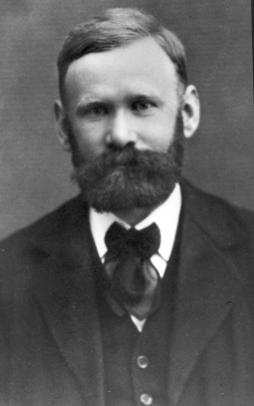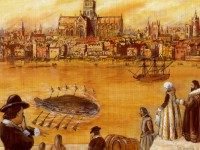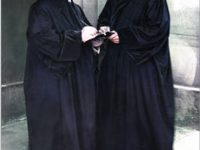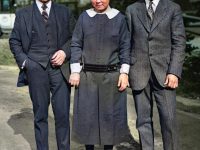On January 1, 1878, Danish mathematician, statistician and engineer Agner Krarup Erlang was born, who invented the fields of traffic engineering and queueing theory. He developed mathematical theories applying the theory of probability, while working for the Copenhagen Telephone Company. He provided significant insights for planning the operation of automatic telephone exchanges that proved so useful that his formulas were used by telephone companies in other countries.
Agner Erlang – Youth and Education
Agner Erlang was born at Lønborg, near Tarm, in Jutland to Hans Nielsen Erlang, a schoolmaster and parish clerk, and Magdalene Krarup, who came from an ecclesiastical family but was descended from the mathematician Thomas Fincke. Agner was a bright child, learning quickly and having an excellent memory.[2] After his primary education, he was tutored at home by his father and another teacher from his father’s school. At age 14, he passed the Preliminary Examination of the University of Copenhagen with distinction, after receiving dispensation to take it because he was younger than the usual minimum age. For the next two years he taught alongside his father.
A distant relative provided free board and lodging, and Erlang prepared for and took the University of Copenhagen entrance examination in 1896, and passed with distinction. He won a scholarship to the University and majored in mathematics, and also studied astronomy, physics and chemistry. He graduated in 1901 with an MA and over the next 7 years taught at several schools. During this time he kept up his interest in mathematics, and he received an award in 1904 for an essay on Huygens‘ solution of infinitesimal problems which he submitted to the University of Copenhagen.[7]
An Acceptable Telephone Service
Erlang’s interests turned towards the theory of probability and he kept up his mathematical interests by joining the Danish Mathematical Association. At meetings of the Mathematical Association he met Johan Ludwig Jensen who was then chief engineer at the Copenhagen Telephone Company, which Erlang joined in 1908 as a scientific collaborator. There, Erlang was presented with the classic problem of determining how many circuits were needed to provide an acceptable telephone service. His thinking went further by finding how many telephone operators were needed to handle a given volume of calls. Most telephone exchanges then used human operators and cord boards to switch telephone calls by means of jack plugs.
The Theory of Probabilities and Telephone Conversations
In 1909, Agner Erlang published “The Theory of Probabilities and Telephone Conversations” proving that telephone calls distributed at random follow Poisson’s law of distribution. Out of necessity, Erlang was a hands-on researcher. At the beginning he had no laboratory staff to help him, so he had to carry out all the measurements of stray currents. He was often to be seen in the streets of Copenhagen, accompanied by a workman carrying a ladder, which was used to climb down into manholes.[3] Further publications followed, the most important work was published in 1917 “Solution of some Problems in the Theory of Probabilities of Significance in Automatic Telephone Exchanges“, which contained formulae for loss and waiting time, which are now well known in the theory of telephone traffic.For example, the Erlang-B formula can be used to calculate the number of telephone lines needed in a call center – the Erlang-C formula can be used to estimate the number of call center agents needed for a given call volume. His papers were prepared in a very brief style and can be difficult to understand without a background in the field. One researcher from Bell Telephone Laboratories is said to have learned Danish to study them.
Later Life
Agner Erlang’s work on the theory of telephone traffic won him international recognition. The British Post Office accepted his formula as the basis for calculating circuit facilities. Moreover, a unit of measurement, statistical distribution and programming language mainly used for large industrial real-time systems have been named in his honor. His name is also given to the statistical probability distribution that he used in his work. Erlang was also an expert in the history and calculation of the numerical tables of mathematical functions, particularly logarithms. Erlang worked for the Copenhagen Telephone Company for almost 20 years, and never having had time off for illness, went into hospital for an abdominal operation in January 1929.
In 1946, at the suggestion of David George Kendall, the International Consultative Committee on Telephones and Telegraphs (CCITT) (the predecessor of the ITU) named the basic unit for traffic in a communications network “Erlang” in his honour. A programming language developed by Joe Armstrong and others at the Swedish company Ericsson was also named after Erlang. However, Erlang can also be interpreted as “Ericsson language”.
Agner Erlang died some days later on February 3, 1929.
Joe Armstrong, Stanford Seminar – Faults, Scaling, and Erlang Concurrency, [9]
References and Further Reading:
- [1] O’Connor, John J.; Robertson, Edmund F., “Agner Krarup Erlang“, MacTutor History of Mathematics archive, University of St Andrews.
- [2] Agner Krarup Erlang – plus magazine – living mathematics
- [3] Who was Agner Krarup Erlang? at informs.org
- [4] Agner Krarup Erlang at Wikidata
- [5] Agner Krarup Erlang at zbMATH
- [6] Agner Krarup Erlang at Wikidata
- [7] Christiaan Huygens and the Discovery of Saturn Moon Titan, SciHi Blog
- [8] “The Theory of Probabilities and Telephone Conversations”. Nyt Tidsskrift for Matematik. 20 (B): 33–39. 1909.
- [9] Joe Armstrong, Stanford Seminar – Faults, Scaling, and Erlang Concurrency, stanfordonline @ youtube
- [10] Brockmeyer, E. (1948), “A Survey of A. K. Erlang’s Mathematical Works”, in Brockmeyer, E.; Halstrøm, H. L.; Jensen, Arne (eds.), The Life and Works of A.K. Erlang, Transactions of the Danish Academy of Technical Sciences, vol. 2, Akademiet for de Tekniske Videnskaber, pp. 101–126
- [11] Erlang, Agner K. (1948), “The Theory of Probabilities and Telephone Conversations”, in Brockmeyer, E.; Halstrøm, H. L.; Jensen, Arne (eds.), The Life and Works of A.K. Erlang, Transactions of the Danish Academy of Technical Sciences, vol. 2, Akademiet for de Tekniske Videnskaber, pp. 131-137
- [12] Timeline of Danish Engineers, via DBpedia and Wikidata







Pingback: Whewell’s Gazette: Year 3, Vol. #21 | Whewell's Ghost